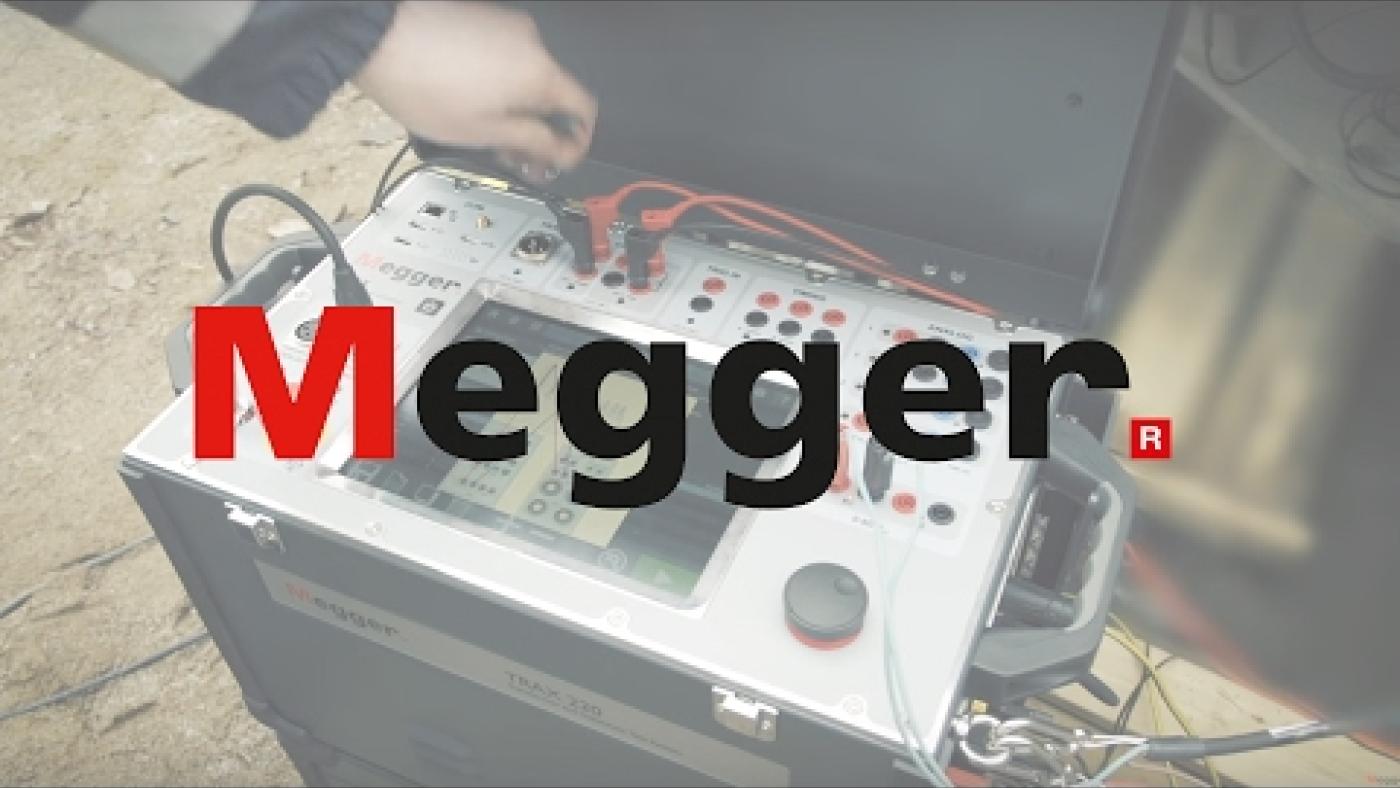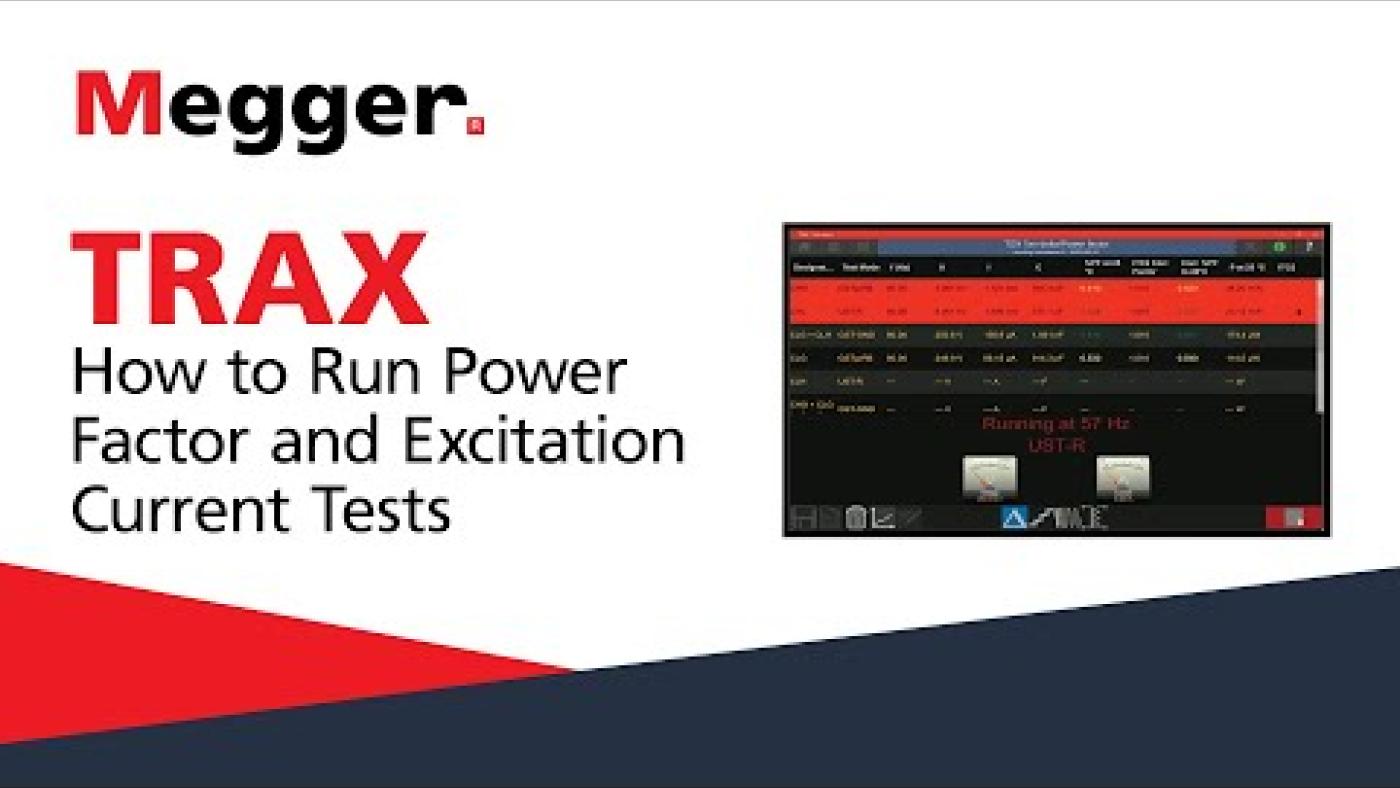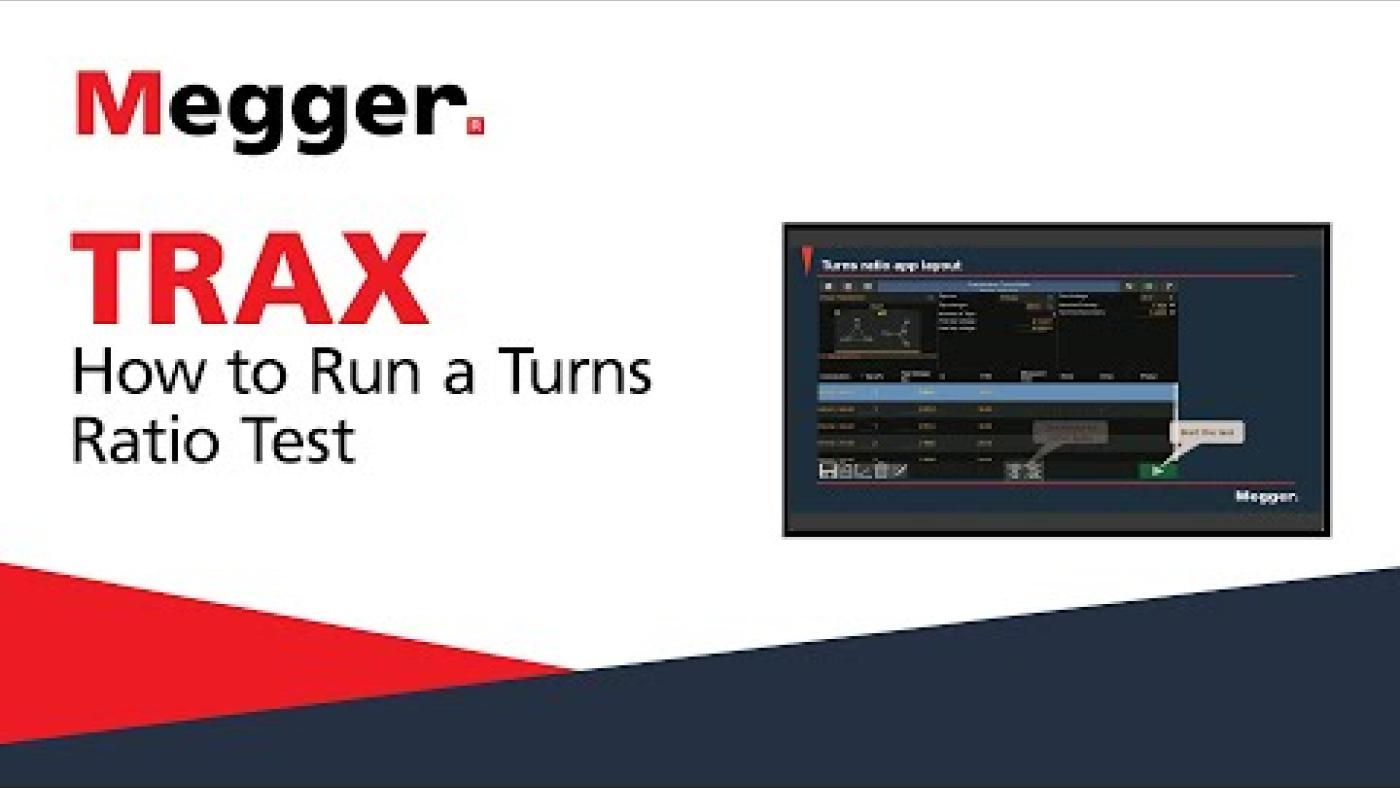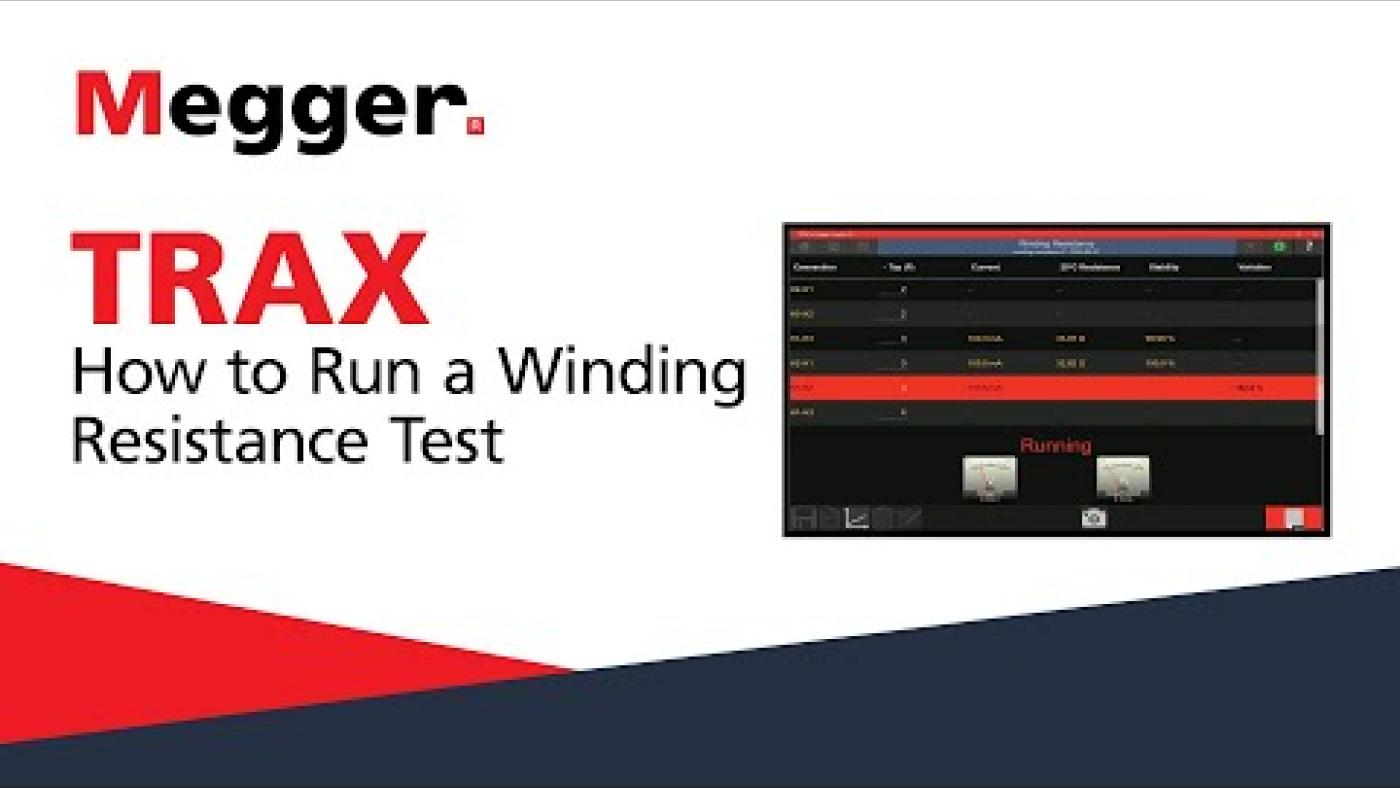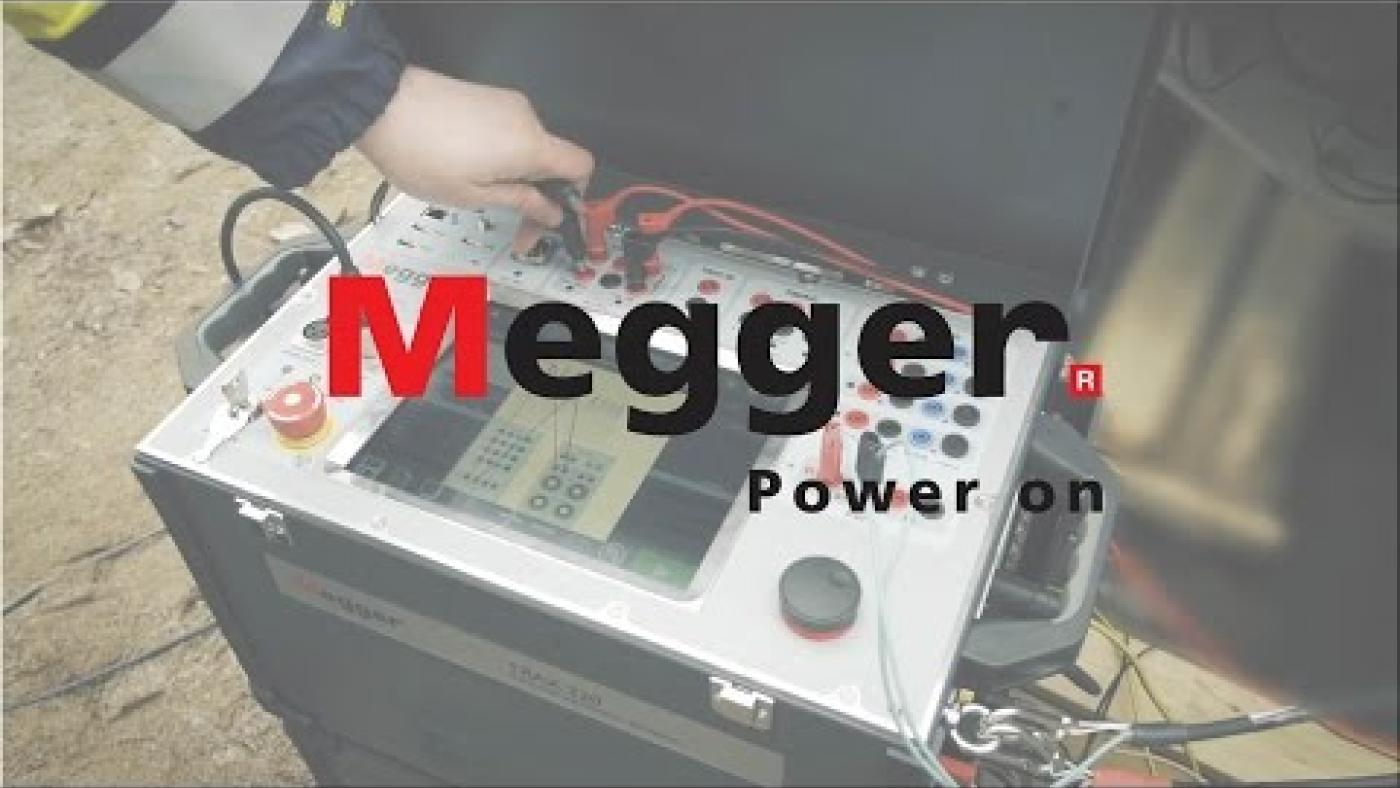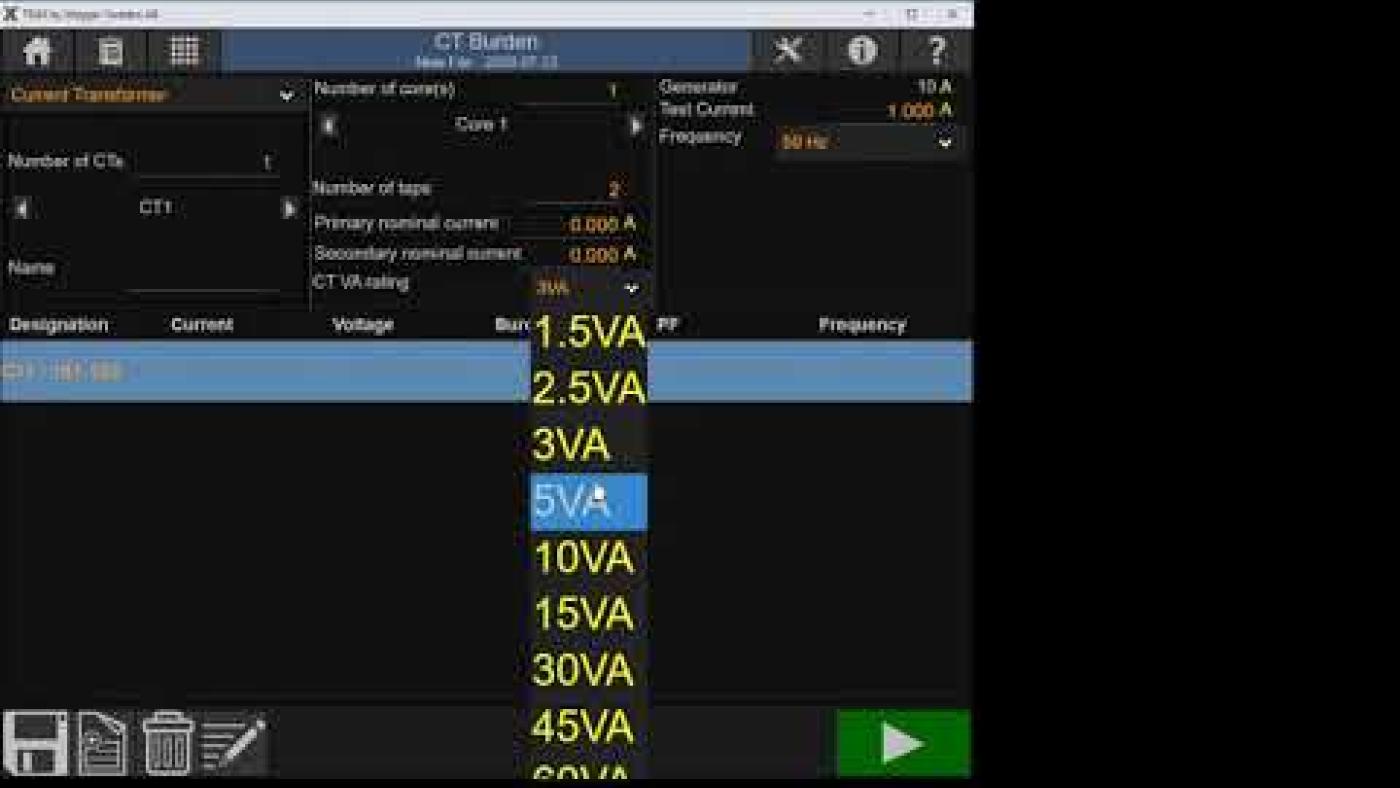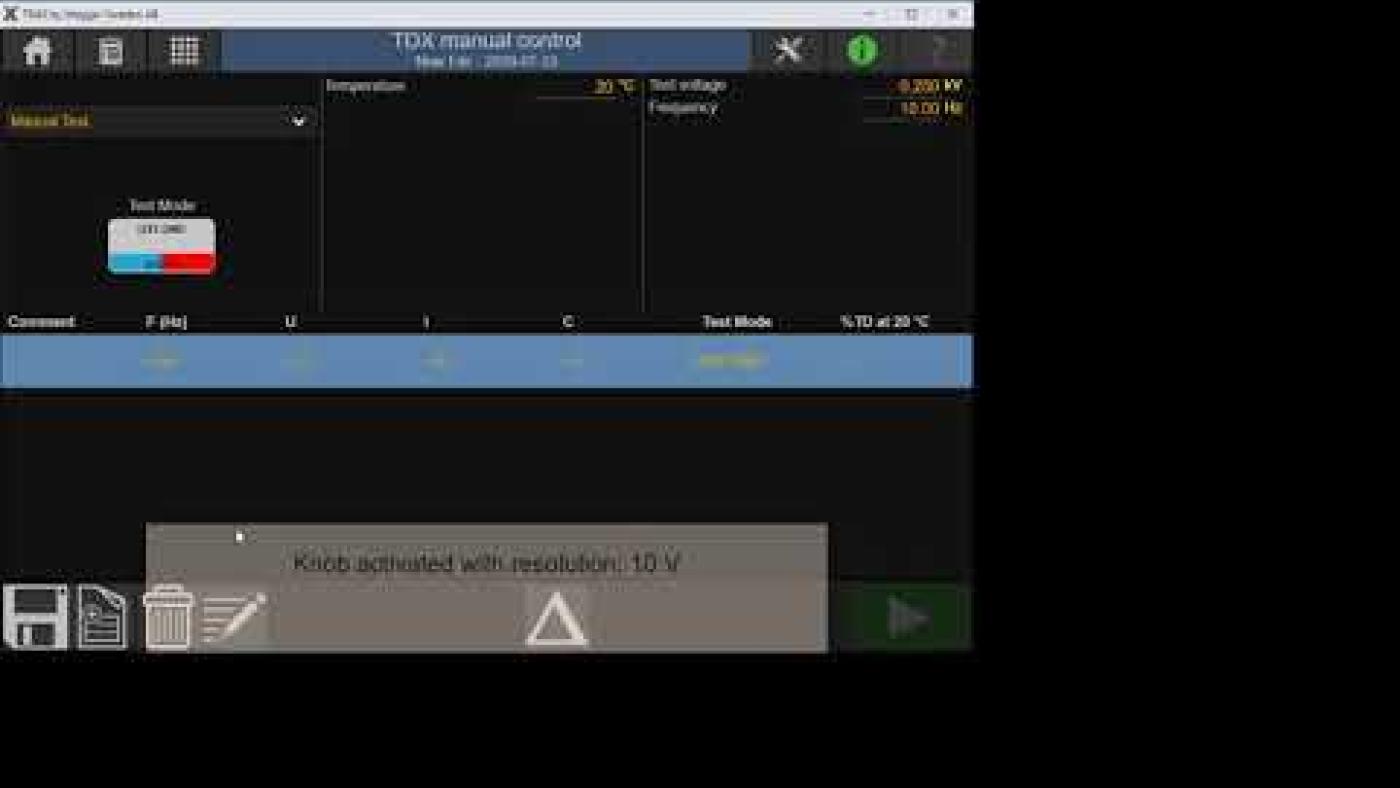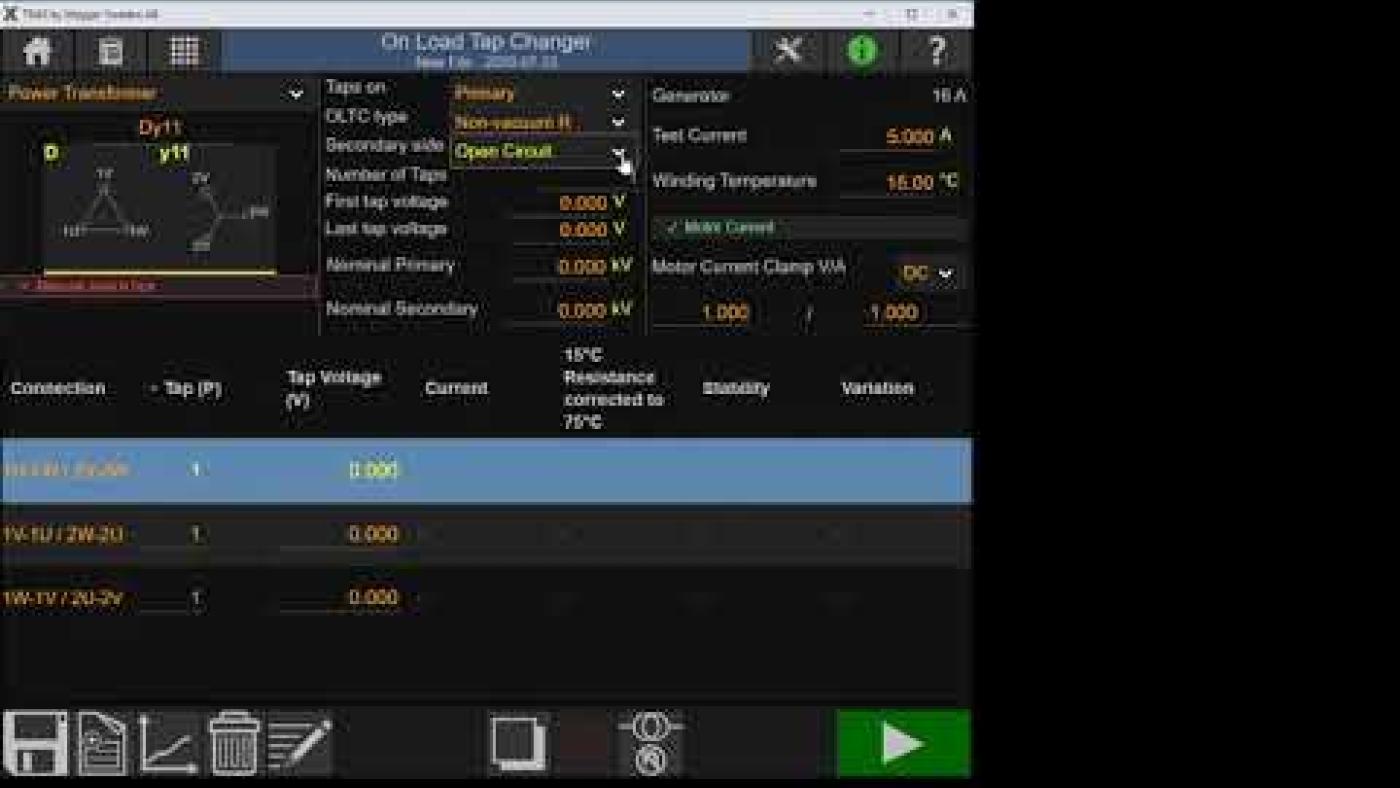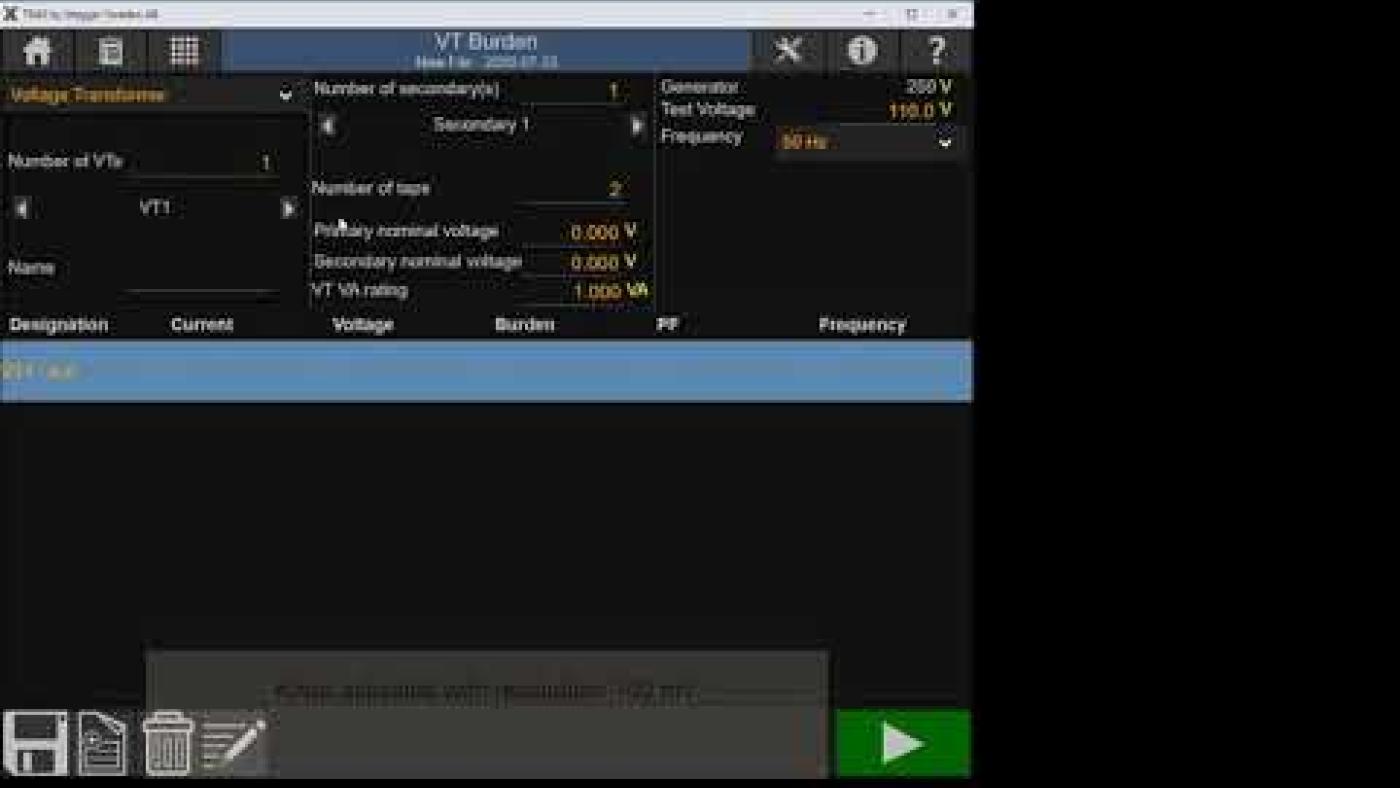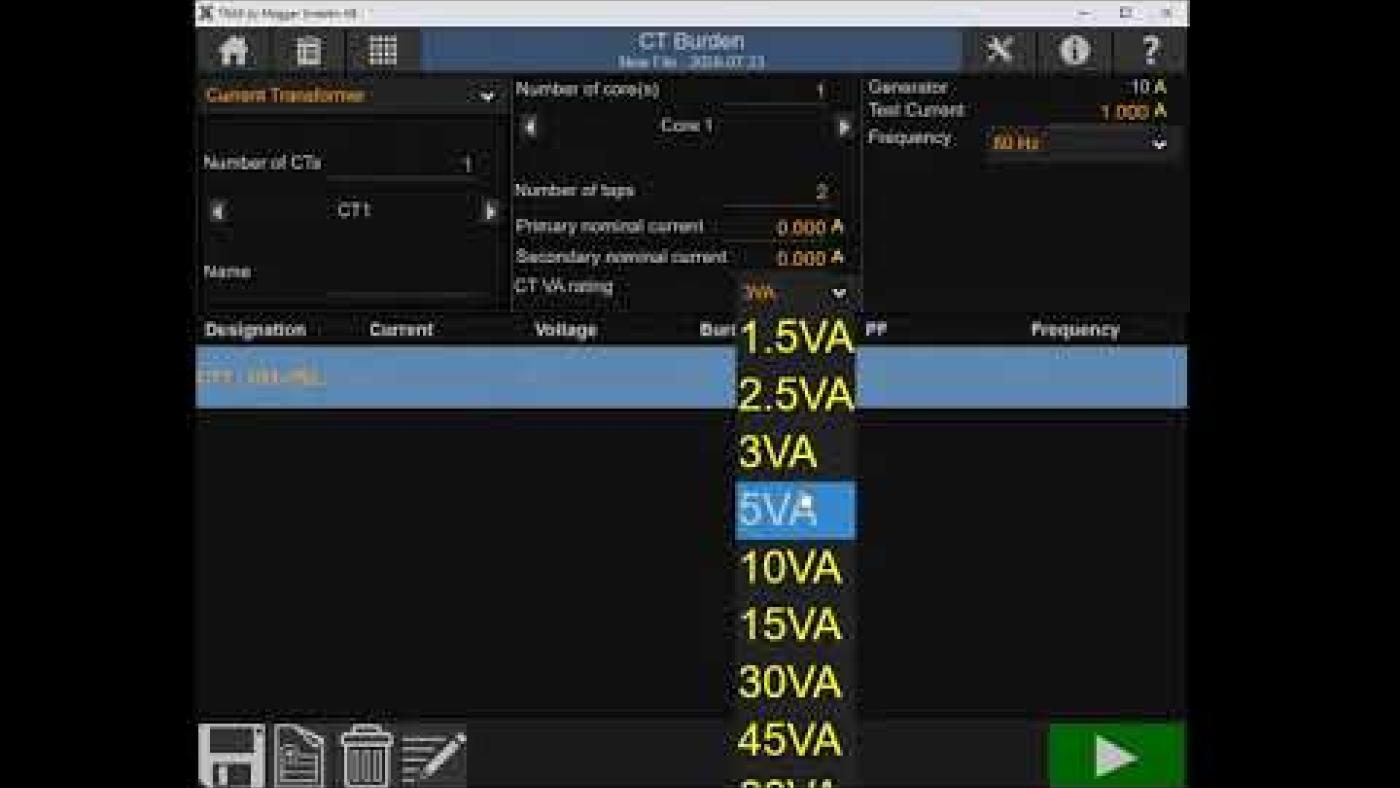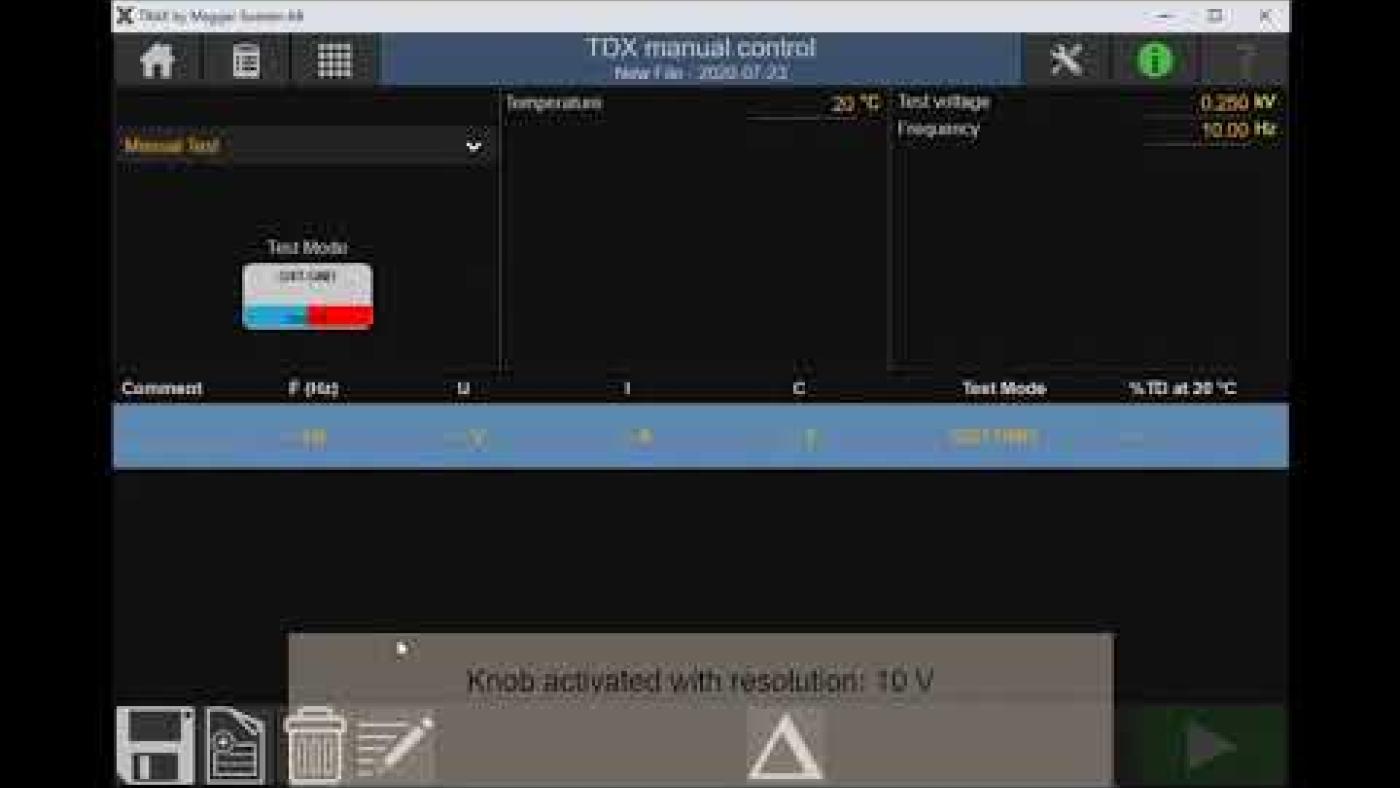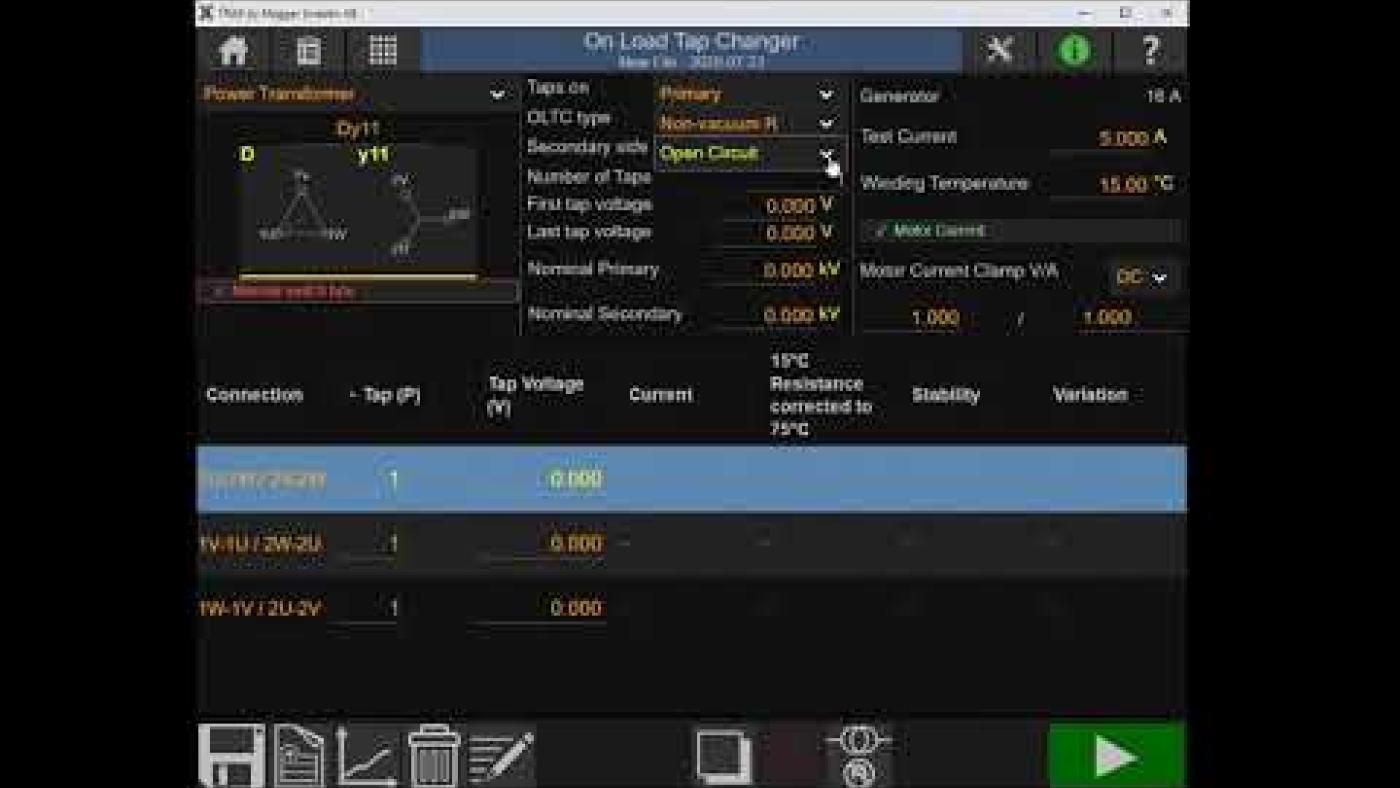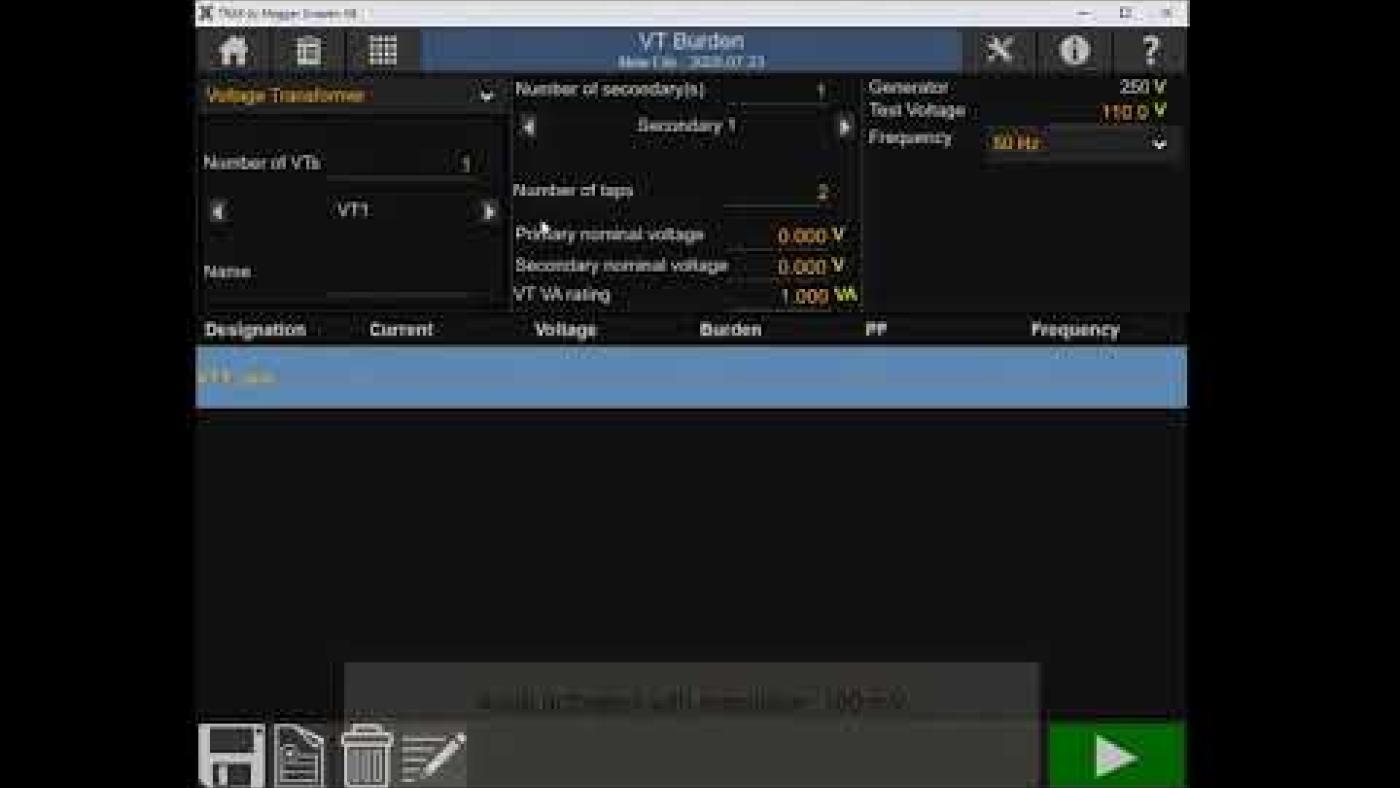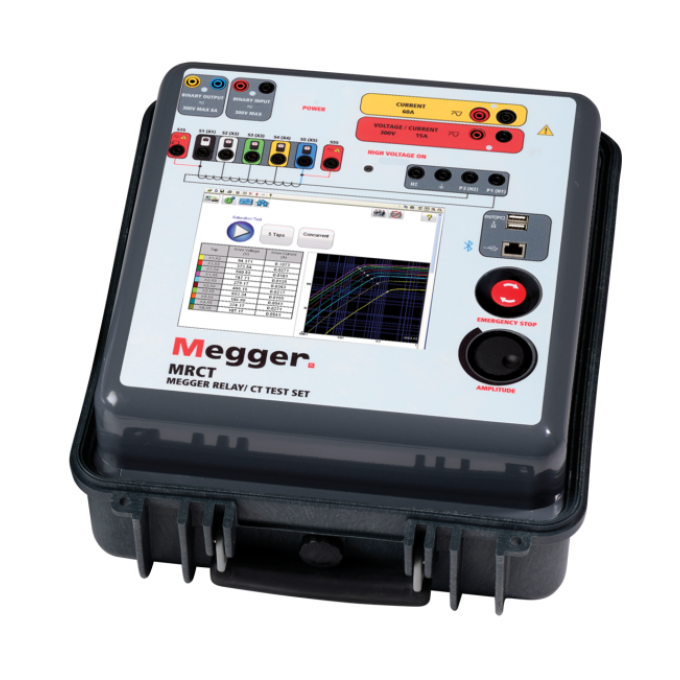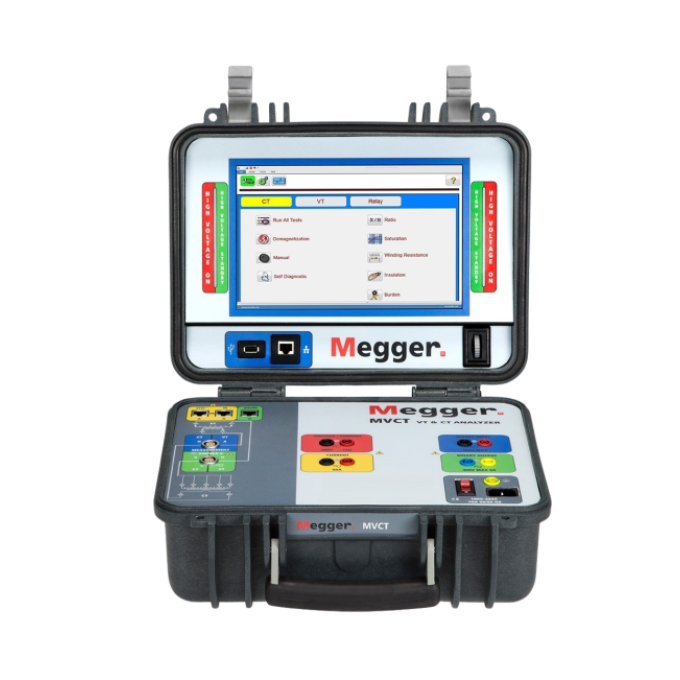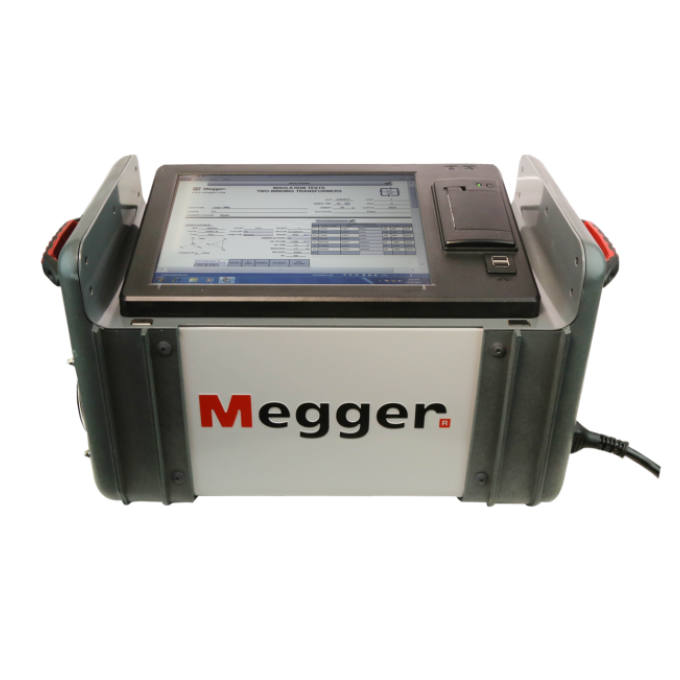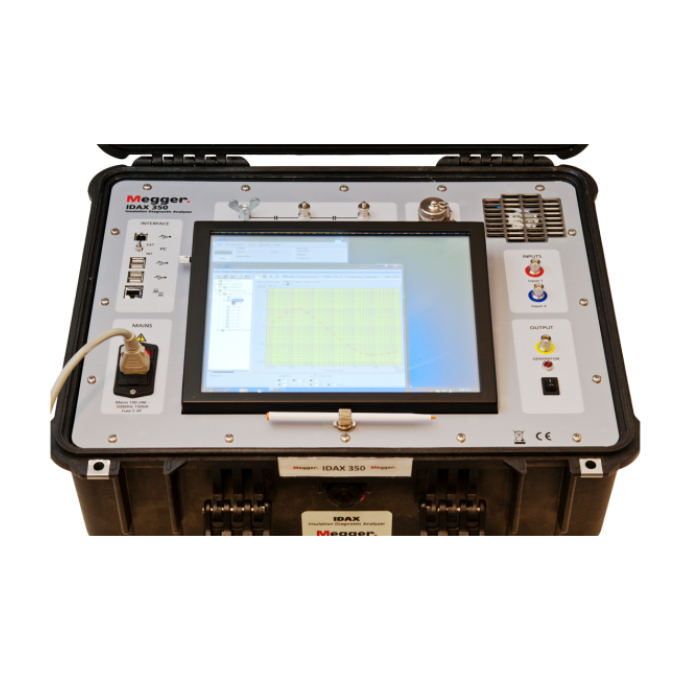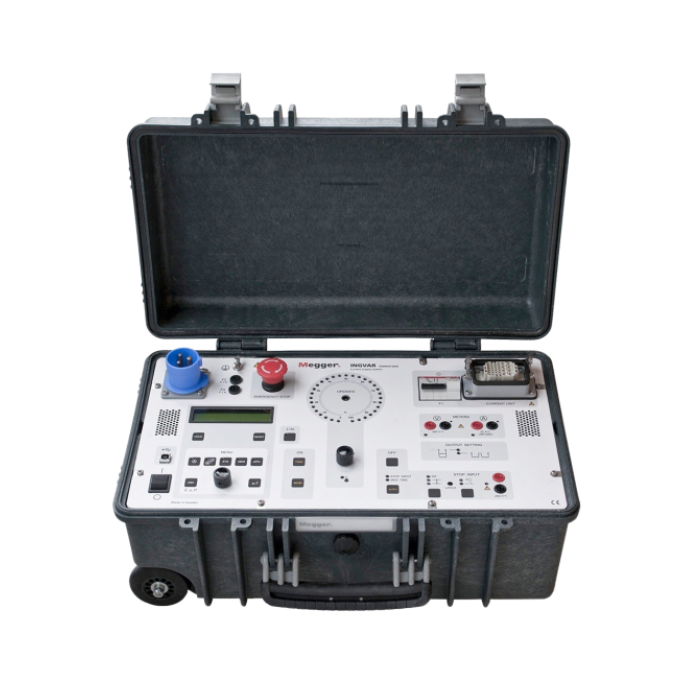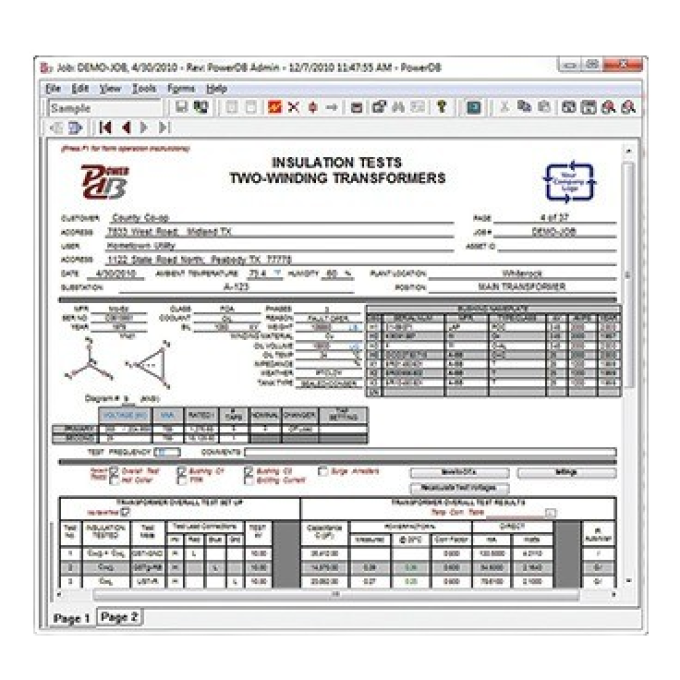TRAX Multifunction transformer and substation test system
Replaces the need for multiple test sets
Perform more than 20 different electrical test functions on power transformers and other substation assets with one device
Powerful, portable and compact system
No part of the system weighs more than 32 kg, making it a truly mobile transformer and substation test system
Reduces user training and testing time
A configurable, easy-to-use interface that displays only the necessary functionality. This gives you simplicity, even when performing complex tasks
Extend the life of power transformers
Assess the condition of assets to reduce downtime and maintain reliability by detecting faults at an early stage
Manage and analyse test data
Present clear and structured reports by exporting the test data to any asset management system for further analysis
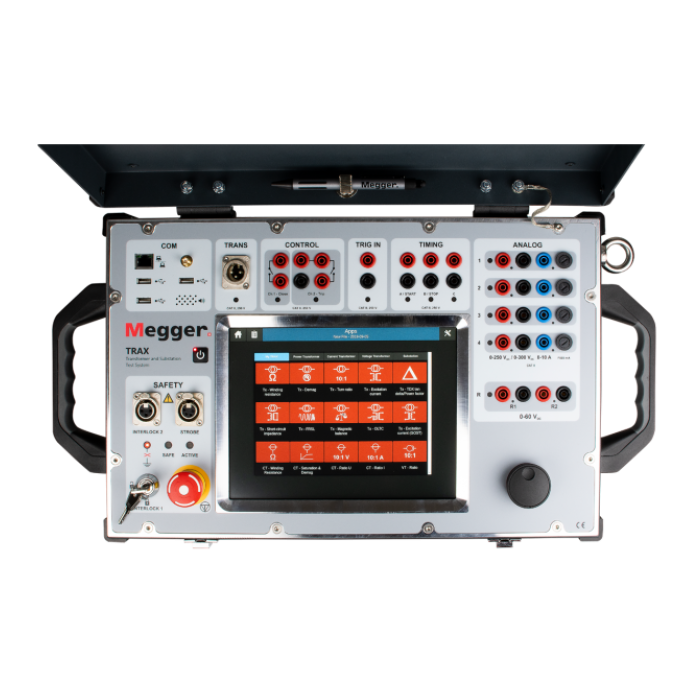
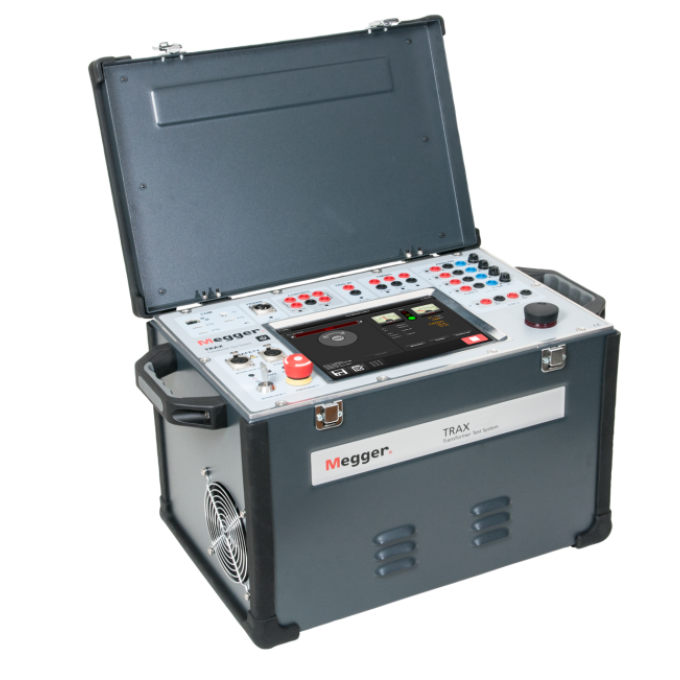
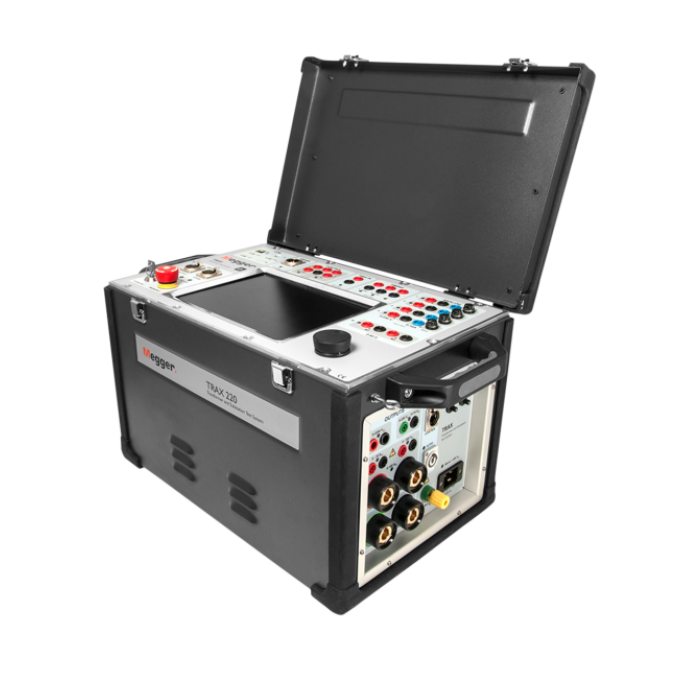
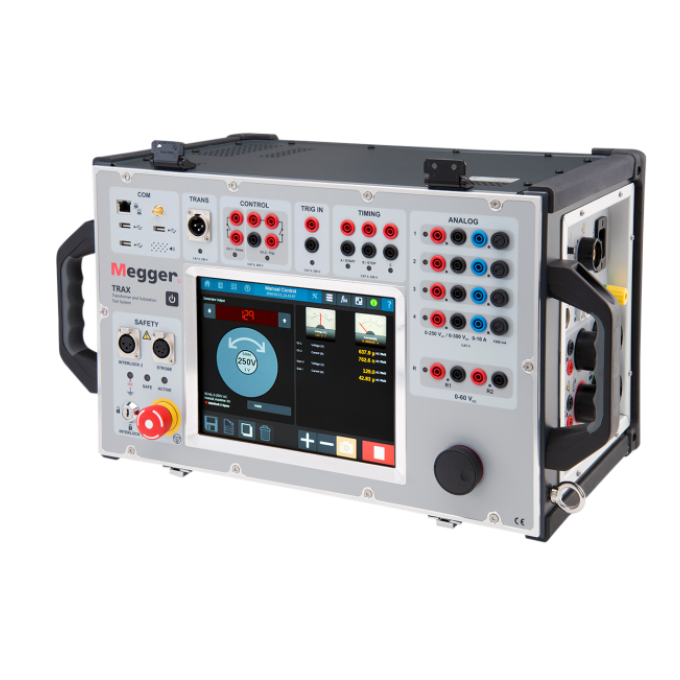
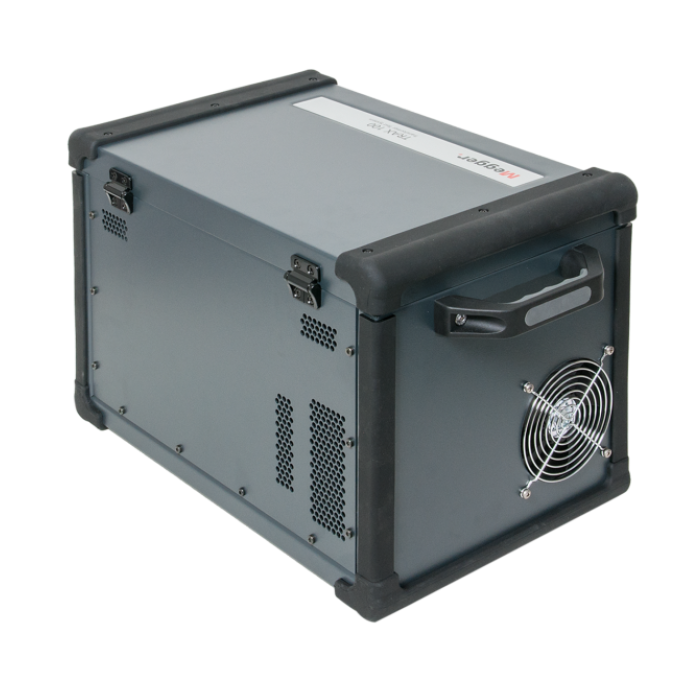
About the product
TRAX is not just a multifunctional test instrument, but many intelligent instruments in one. The software includes several apps, making it fast and easy to perform a large range of different tests. The hardware, range of cables and accessories offers unmatched flexibility, making the TRAX an efficient and time-saving system.
TRAX is packed with functionalities to make the test engineer’s task easier and quicker. For example, the 100 A true DC test current with a 50 V compliance voltage for winding resistance measurements or the 250 V AC voltage for turns ratio measurements. Also, the adaptive technique for the fastest and most efficient demagnetisation of a transformer core and the patented technique for acquiring authentic, dynamic resistance measurements on on-load tap changers to determine the real magnitude of transition resistances and transition times. TRAX also features 12 kV power factor/tan delta testing, patented temperature correction, voltage dependence detection, and narrowband dielectric frequency response (NB DFR) testing, making it a robust transformer test system.
TRAX includes Megger's market leading circuit breaker testing technology and is the only multifunctional test set on the market that offers the following tests:
- Timing test (O, C, OC, CO and OCO)
- Coil supply voltage (Station voltage)
- Pre-insertion resistance (PIR)
- Open coil current
- Breaker analysis graphs (timing, voltage, current)
TRAX offers full manual control of inputs and outputs - a unique tool for immediate troubleshooting. Routine procedures can be reproduced or modified using the manual control features to vary voltage, current, and/or frequency. TRAX is a portable metrology laboratory ideal for advanced users, research institutions, and root cause analysis specialists.
Manual control gives you access to control and operate:
- 10 generators (AC and DC; voltage and current)
- 6 measurement channels (AC and DC; voltage and current)
- Electrical formulae calculator
- Real-time oscilloscope
Technical specifications
- Input voltage
- 100 - 240 V, 50/60 Hz (±10%)
- Max output current (DC)
- 100 A (2 min), 70 A (continuous)
- Test type
- Complete transformer test systems
- Test type
- Capacitance and dissipation/power factor
FAQ / Frequently Asked Questions
Megger has a universally acknowledged commitment to safety and as such has equipped TRAX with a full range of safety features. These include ground-loop detection, dual interlocks, and facilities for fast discharge of inductive measurement objects. Sequence monitoring is also provided to ensure that all test connections are made correctly and in the right order. There’s also a readily accessible emergency shutdown button, and provision for connecting an optional strobe warning light.
The TRAX test set is a well-equipped electrical laboratory in a box, complete with an integral oscilloscope. Fundamentally, TRAX test sets generate and monitor AC and DC voltages and currents. These voltages and currents can be used as the basis for virtually any test procedure, which means the future extendibility of TRAX is potentially unlimited. New tests can be performed manually by experienced users, or new apps can be developed to automate them. Accessories, such as the three-phase switch box, can also be added.
FRSL stands for frequency response of stray losses. It’s a technique for detecting strand-to-strand short-circuits in transformer windings by performing short-circuit tests over a wide range of frequencies. Diagnostics based on FRSL rely on comparing the results obtained in a test with earlier measurements, with tests carried out on an identical transformer, or between phases. Measurements are made on the high voltage (HV) side of the transformer, with the low voltage (LV) side short circuited. FRSL tests can be performed with Megger FRAX and TRAX test sets.
The measuring techniques used are similar but, as the name implies, narrowband DFR uses a much more restricted range of frequencies – usually from around 1 Hz to 500 Hz. Also, the results are analysed directly rather than by using modelling techniques. It takes much less time to carry out a narrowband DFR test than a full DFR test – around two minutes compared with upwards of twenty minutes in some cases – but the narrowband test doesn’t provide the estimated moisture content for the cellulose insulation or oil conductivity. What it does do is provide an earlier indication of problems than a traditional power factor/tan delta test performed only at power frequency. It also confirms that seemingly good power factor/tan delta values really are good and allows the transformer’s individual temperature correction (ITC) factor to be determined. Narrowband DFR testing is supported by Megger test sets in the TRAX and DELTA4000 ranges.
The use of an instrument that has been designed with transformer resistance testing in mind is strongly recommended as it will give more dependable results more quickly and more safely, especially with large transformers. It will also include provision for demagnetising the transformer core after testing has been completed. This is important as, if a transformer is returned to service with a magnetised core, a large and potentially damaging inrush current may flow. It may not, however, be necessary to use a dedicated transformer ohmmeter. The TRAX multifunction tester provides an extensive range of tests for transformers, including not only winding resistance tests, but also (for example) turns ratio tests, leakage reactance measurements, and power factor/tan delta measurements. These testers can also perform basic measurements on circuit breakers, protection relays, and many other items of equipment used in power distribution networks. For many users, they are a better and more useful investment than a dedicated single-function transformer ohmmeter.
The TRAX measures dynamic resistance in the on-load tap-changer by simultaneously measuring the test current together with voltages on both HV and LV windings as the OLTC operates. These results are used together with transformer modelling. The LV winding is left open. Due to the consequent inductance in the circuit, the change in voltage measured across the HV winding is rather large. This voltage is a sum of inductive and resistive voltages and cannot be used for directly calculating the resistance in the circuit. However, the voltage measured across the LV winding is purely inductive. By using transformer model parameters to calculate the inductive voltage on the HV winding, this value can be deducted from the total measured HV winding voltage and then the resistance in the circuit can be calculated. This is a Megger patented method.
With DC resistance measurements, the objective is always to try to saturate the transformer core as this reduces the effective inductance of the winding and allows the test current to stabilise more quickly. Saturation requires a minimum test current of 1 % of the rated current for the winding. It is, however, usually advantageous to use a somewhat higher test current than this, particularly when the rated current of the winding is high, in which case, a higher test current may speed up the time to saturation. If the test current is too low, it will often be found that successive measurements give inconsistent results. Nevertheless, test currents of more than 15 % of the rated current should be avoided, as they are likely to lead to erroneous results due to the heating of the winding. In most cases, the optimum test current is between 1 % and 15 % of the rated current. It should be noted, however, that it is the compliance voltage of the test instrument that determines the saturation rate of a transformer during this test. For this reason, compliance voltages above 40 V DC are preferred. The Megger TRAX provides up to 100 A true DC at up to 50 V compliance voltage.
Winding resistance tests are usually carried out on new transformers after they are delivered to site and before they are put into service as a way of detecting transit damage. Such tests will also provide baseline results for comparison with measurements made throughout the life of the transformer. Winding resistance tests should be performed as part of scheduled maintenance as an aid to detecting incipient faults; this is arguably one of the most important routine tests that one can do on a transformer. Finally, winding resistance tests are invaluable when finding faults in transformers, as many transformer faults or problems will cause a change in the DC winding resistance.
No, but some people refer to it as such. A ‘ripple test’ does constitute a dynamic measurement on an OLTC. In all OLTC dynamic measurements, a current is injected in the tap changer, either in one phase or all phases, and during the operation of the tap changer, the current and/or the voltage is measured as a function of time. In a ‘ripple test’, the current is measured and the result is presented in a current-time diagram or as a percentage ripple value. Ripple is the magnitude by which the test current decreases during the tap change; it is expressed as a percentage of the test current. The behaviour of the current is affected by the resistance of the transition path and the speed of the tap change operation. However, a ripple test cannot provide transition resistor values or transition times.
Further reading and webinars
Related products
Troubleshooting
The ground loop detector must be satisfied that there is a common ground between the test instrument, the instrument’s power source, and the asset under test. If the ground loop resistance is too high, the light between the Interlock 1 key and Interlock 2 plug will light up, and the screen will display a ground loop detection (GLD) failed message. In this case, ensure that the mains ground is connected to the same ground grid as the TRAX protective conductor that connects to the test object ground.
Note: You can toggle the ground loop detector on or off for all generators except the 2 kV generator and the TDX120 accessory.
The TRAX has several different software options depending on the package and accessories that you purchased. All TRAX test sets come with manual control, turns ratio (TTR), winding resistance (WR), adaptive demagnetisation, excitation current (2 kV), and short-circuit impedance (leakage reactance). These apps should always be available. Additional apps are available if you purchased those packages, and you can unlock them with a code specific to the serial number of the TRAX. There are also certain apps that can only be operated when additional hardware is connected, for example, the tan delta/power factor app with the TDX120 high voltage unit. If you do not have the accessory or even the TRAX available, you can still create a test template in the TRAX software when using offline mode.
You can upgrade the TRAX software easily via the internet or with a USB:
Upgrading via the internet:
- Connect the TRAX to an open internet port with unlimited access, e.g., some networks limit access to hardware and devices that the IT department didn’t issue. In this case, they will need to give TRAX permission on the network. If this is not an option, then updating via USB is available.
- Select “Global Settings” from the home page and “Update.”
- The TRAX will start searching for available updates, and if/when an update is found, it will display “Update available.” Download the update.
- Start the updating process.
Upgrading via USB:
- Download the update from the link below and place it on a USB stick in the root directory.
- Insert the USB stick into one of the USB ports on the TRAX.
- From the home page, select “Global settings,” then “Updates” and “USB.”
- Download the update.
- Start the updating process.
We recommended restarting the TRAX after an upgrade.
Interlock 2 cannot be deactivated for the 2.2 kV output or when using the TDX120 accessory. You can, however, deactivate Interlock 2 for the other lower voltage and current outputs. The keyed Interlock 1 is always required.
Interpreting test results
The TRAX is a unique device that is a multifunctional solution for transformer and substation testing. With its manual control, you can program the TRAX to change inputs and outputs as well as perform mathematical functions on the measurements so that interpreting results can vary widely since multiple combinations of inputs and outputs can be applied. The TRAX also has multiple power transformer and instrument transformer apps with predefined test parameters. Hence, an interpretation of the results is almost endless or at least too large to fit in this section. Therefore, we provide analytic tips for the standard transformer tests here or a link to other dedicated products' results interpretation sections that perform the same type of test. You may find data interpretation guidelines for additional tests in Megger application notes or technical guides. A convenient data interpretation summary table is included below for your convenience.
Two of the most common tests performed on a power transformer are transformer turns ratio (TTR) and winding resistance (WR). These apps are available in the standard transformer package of the TRAX. TTR measures the cumulative turns to cumulative turns ratio between the primary and secondary, or primary and tertiary, windings. A change in TTR values can be due to shorted turns, open turns, tap changer malfunction, core problems, or incorrect or improper winding connections.
WR evaluates the transformer windings and tap changer(s). Changes in resistance values (after temperature is taken into account) are indications of shorted turns, broken strands, faulty or corroded connections between winding and bushings, or within a tap changer.
Megger's MWA instrument is explicitly dedicated to TTR and WR;
click here to see the MWA product support page for results interpretation on TTR and WR tests.
With the optional TDX 12 kV booster box, you can perform power factor (PF) or tan delta (TD) to evaluate the insulation condition of the transformer. A PF test can indicate deteriorated insulation and wet oil and paper in the transformer and bushings. With narrowband dielectric frequency response (NBDFR), you gain further insight and more confidence in your PF readings. With the high voltage source of the TDX, you can also perform a high voltage excitation current test that helps to detect winding and core problems.
The Megger DELTA4000 test instrument is a dedicated PF and TD instrument. Click here to see the DELTA4000 product support page, where you will find data interpretation guidance for both PF and excitation current.
The TRAX's standard transformer package also provides a short circuit impedance or leakage reactance app. Theoretically, a transformer's primary and secondary winding should be 100 % coupled by magnetic flux. But in reality, a transformer always has a small amount of leakage flux. The number of winding turns cut by leakage flux largely depends on a winding's position. This, in turn, influences leakage reactance. Thus, a physical or mechanical change in the windings can change leakage reactance from its benchmark value.
This test involves injecting AC current into the primary winding and measuring the voltage drop across the winding while the secondary winding is shorted. At the transformer factory, three-phase injection is used for impedance testing. Three-phase injection is not practical in the field, so current is injected into line-line winding terminals.
Two methods are typically performed in the field: a three-phase equivalent test (check nameplate impedance on the setup screen in the TRAX) and a per-phase test. The result of a three-phase equivalent test can be compared to the nameplate impedance on the transformer, assuming it is a Delta or Wye connection. Zigzag transformers require a three-phase source, so these tests are not performed for these configurations. Per-phase leakage reactance tests, meanwhile, are more sensitive to winding deformation than three-phase equivalent tests.
The difference between per-phase leakage reactance results is typically less than 2 %. A three-phase equivalent impedance result should not differ from the nameplate impedance by more than 2 to 3 %. IEEE C57.152 allows 3 % compared to the factory report, whereas CIGRE445 allows only 2 %. This percentage change is not an absolute percentage change but a change in the percentage of the actual value, e.g., if the nameplate is 5.0 % and the three-phase equivalent measurement is 5.4 %, this indicates a difference of 8 % and needs to be investigated. When comparing to the factory report, you must be on the same tap and power rating at which the factory measured the impedance. A significant change in impedance warrants your further investigation. A Sweep Frequency Response Analysis (SFRA) test is beneficial in confirming a problem in such a case.
| Interpretation summary | |
|---|---|
| Turns Ratio Test | Measurement ±0.5 % vs. nameplate. |
| Magnetic Balance | The sum of induced voltages should add up to the applied voltage. With the mid-limb excited, the extreme limbs will have 40 to 60 % induced voltage. With the extreme limbs excited, the middle limb will have 60 to 90 % induced voltage and the other extreme limb will have 10 to 40% induced voltage. |
| Winding Resistance Test | Comparative analysis for three-phase between windings gives an error between 2-3 %. Each winding evaluated individually. |
| Leakage Reactance | 3-phase equivalent short circuit impedance should be within 2-3 % of nameplate. |
| Dynamic Resistance Measurement | Comparative analysis: Timing; Ripple; Resistance Value |
| Frequency Response of Stray Losses | The analysis of FRSL results is best carried out by making comparisons with the results of earlier test made on the same transformer. Short-circuited strands reveal themselves in the data as curves that overlay at low frequencies and then start to diverge at higher frequencies. CIGRE 445 Guide for Transformer Maintenance, defines the fail criterion for the FRSL diagnostic as a difference in AC resistance between phases of greater that 15 %. |
| Exciting current | Symmetrical phases within 5 %. Typical phase pattern of two similar high and one low. |
| Transformers Line-frequency DF/PF at 20℃ | For transformers > 230 kV, 0.4 % For transformers < 230 kV, 0.5 % Service aged units < 1 % |
| Capacitance and DF/PF | As published by IEEE C57.152, in the field, transformer insulation systems should not change by more than 5 % from the benchmark results. If the results are above 5 % and below 10 % change, an investigation needs to be conducted to determine the extent or severity of the issue. If the capacitance has changed by more than 10 %, the transformer should not be returned to service. |
| Transformers 1 Hz DF/PF at 20℃ | Good < 1 % Service aged between 1 and 2 % Investigate < 2 % |
User guides and documents
Software and firmware updates
FAQ / Frequently Asked Questions
With DC resistance measurements, a central objective is to try to saturate the transformer core, as this reduces the effective inductance of the winding and allows the test current to stabilise more quickly. Saturation typically occurs when the DC test current is over 1 % of the rated current for the winding. It is usually advantageous to use a somewhat higher test current than this to minimise the effect of noise on the measurements. If the test current is too low, you will often find that successive measurements give inconsistent results. Nevertheless, you must avoid using test currents of more than 15 % of the rated current, as they are likely to lead to erroneous results because of the resultant heating of the winding. In most cases, the optimum test current is between 1 % and 15 % of the rated current.
When performing a TTR or WR test with the TRAX, the form settings give you the option of testing by tap or testing by winding. These options have different advantages depending on the TRAX accessories you have and what test you are performing. You should perform TTR tests by tap or by winding, depending on the availability of a switchbox.TTR by winding (no switchbox):We recommend performing the test by winding if you have a TRAX without a three-phase accessory and are performing TTR testing on multiple taps. This testing approach allows you to connect leads one time to the phase under test and then proceed through all the taps. After completing TTR testing on all taps in the first phase, ensure the TRAX output is de-energised before you switch the leads to the next phase. Continue testing, beginning at the tap position on which you finished testing on the previous phase winding. There is no need to move the tap changer back to the position on which you began Phase 1 tests; instead, test the second phase in the reverse tap order. Make sure to have “Reversed order for next connection” checked. That way, if you begin testing on the highest tap for the first phase, the software will assume that you will commence testing on the lowest tap for the second phase, then reverse once again on the third. Using this method, you only need to connect to the transformer three times to perform all TTR tests. Conversely, if you tested ‘by tap,’ you would have to change test connections after every measurement, thus changing leads frequently. The number of lead changes, as an example, would amount to three times per tap multiplied by the number of the transformer’s tap positions. TTR by tap (with a switchbox):We recommend performing the TTR test by tap if you have the automated three-phase switchbox (TSX 303) or the manual three-phase switchbox (TSX 300). With the automated switchbox, the TRAX will measure one phase, automatically switch to the next phase, and then the next. When all three phases have been tested, the TRAX will prompt you to switch the tap position to proceed testing. The manual switchbox allows you to conveniently change the dial from one phase to another in between tests instead of changing lead connections on the transformer. With the switchbox, you only need to connect to the transformer once, and you only need to cycle through the tap changer positions once. Winding resistance (by winding):When performing a WR test on a transformer with an on-load tap changer (OLTC), we recommend testing by winding whether or not the TRAX is equipped with a switchbox. This test progression allows the WR application to test the ‘make before break’ functionality of the load tap changer. The TRAX will detect interruptions in current by keeping the current continuously running through the winding while changing taps. Interruptions in the current can indicate a faulty tap changer. Additionally, by testing one winding and cycling through the taps, the core saturates on the first measurement, and successive measurements on the same phase are performed much more quickly.
The TRAX ecosystem offers several ways to add additional tests or retest. Suppose you want to repeat a test that has already been recorded and overwrite the results. In that case, you click on the line you want to test, make the appropriate connections, and select the play button. This action will overwrite the previous data. The software will advance to the following line, so make sure you select the next appropriate test if not retesting sequentially. If you have already left an application and, while viewing the report, discover that you need to repeat one of the tests, you have two options. To overwrite previous results, you must go to the report section and click on the “Edit” button in the upper right corner. Once clicked, a small taskbar will appear at the top right of each test sequence on the report. From here, you can choose to re-measure by clicking the “Play” button. The software will open the appropriate app with the previously measured data populated when you click “Play”. Click on the line you want to retest and test as usual. There may be instances where you want to perform the same test but keep previous results. If this is the case, select the instrument selection button and then the appropriate app; this will create a new test sequence on the same report.
Since the TRAX has multiple inputs and outputs at various settings, it may perform the same test using different connections. Check that you are using the appropriate voltage or current setting for the measurement; e.g., when performing the winding resistance test, there are three options, 1 A, 16 A, and 100 A. Each setting uses a different current output connection on the TRAX. You can utilise optional switchboxes if performing TTR or WR tests. If using the manual switchbox (TSX 300) for TTR and WR, make sure that the “Manual switch box” option is checked (underneath the vector diagram) in the TTR and WR app. If using the automated switchbox (TSX 303), the TRAX will automatically detect that the TSX 303 is connected and adjust the connection diagram.
Make sure to take the reading only after the voltage has stabilised. You may need to toughen your ‘stable’ criterion setting to 99.95 % for more than 5 seconds. Waiting for more stable readings should reduce the deviation. Sometimes the variation in a measurement that has a very low absolute value, such as 1 mΩ, can result in a substantial divergence between phases. Still, the actual value may be just a few µΩ greater than expected, and there is no genuine issue with the transformer winding.If the asset under test is a large power transformer, consult reference measurements with the manufacturer or compare your results against factory test results. Construction constraints of these large transformers might result in larger, yet acceptable, WR differences between phases. A good example of this is a transformer with an LTC in one of the short segments of the tank, which will result in considerably different lengths for the conductors used between the tap changer and each tap winding.
The algorithm finds the timing for the OLTC based on the expected curve. A faulty tap changer can result in a curve that is different from the expected value. Examine the graph and look at the curve transition, where you should find the timing and/or problem with the tap changer.
The TRAX offers complete manual control of inputs and outputs - a unique tool for immediate troubleshooting. You can reproduce or modify routine test sequences using the manual control features to vary voltage, current and/or frequency. A notable caveat is that the discharge function is not implemented in manual mode. Therefore, while you can run a contact resistance test in manual mode, you should not attempt a winding resistance test.The TRAX is a portable metrology laboratory ideal for advanced users, research institutions, and root cause analysis specialists. Manual control gives you access to manage and operate:
- 10 generators (AC and DC; voltage and current)
- 6 measurement channels (AC and DC; voltage and current)
- Electrical formulae calculator
- Real-time oscilloscope
